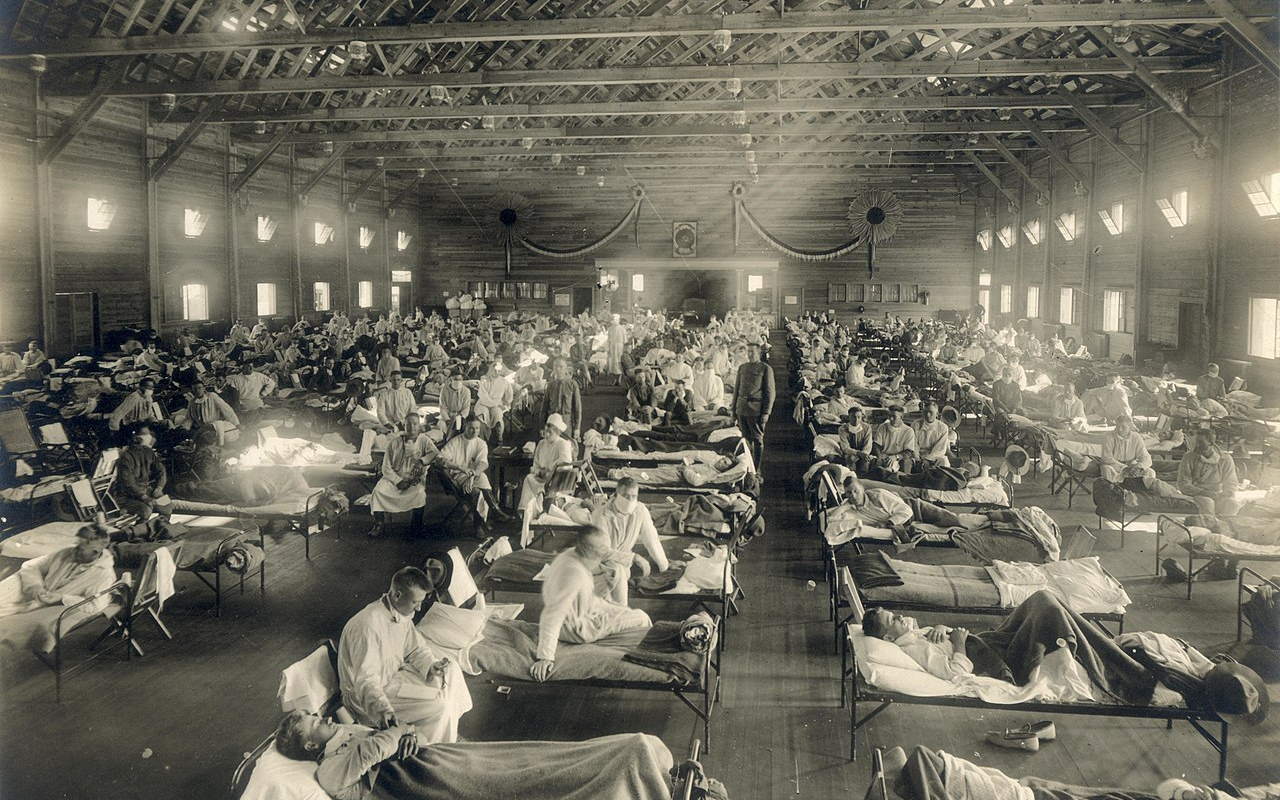Lindsay Holiday published two-part very informative video series titled “A History of Pandemics” on Youtube. These pandemics (and epidemics) have occurred countless times in the past, infecting, injuring and killing millions, and sometimes changing dramatically the course of human history.
But, first, what is a pandemic? What is an epidemic?
What is an epidemic? What is a pandemic?
Epidemic
When an infectious disease occurs widespread disease in a community at a particular time, it’s called an epidemic.
Pandemic
If an infectious disease prevalent over a country, a continent, or the whole world, then it is a pandemic.
History of Pandemics
Epidemics and pandemics have occurred countless times in history (end in the prehistoric ages too) – infecting, injuring, and killing millions of people. They’ve changed many lives and sometimes the course of human history in countless ways.
But, in the end, humanity has always continued to move forward and in many cases, we have learned from these horrible outbreaks to develop new techniques of treatment and prevention.
Furthermore, we’ve made massive strides forward in sanitation, hygiene, and nutrition – making the human population healthier and less vulnerable to illness. People today are living longer, healthier, and happier lives than ever before.
Here’s the two-part video series by Lindsay Holiday titled “A History of Pandemics” below.
Disease, it’s a terrifying prospect. A myriad of infectious diseases perpetually surrounds us causing severe, mild, or even no reaction at all depending on your health, immunity, and sometimes sheer luck. Epidemics and pandemics have occurred countless times in the past, infecting, injuring, and killing millions. They have changed many lives and affected the course of human history in countless ways. But in the end, humanity had always continued to move forward. Let’s look back at some of the worst diseases and pandemics in history.
History of Pandemics – death comparison
Another horrifying video – pandemic death comparison, showing the death toll of the pandemics as the volumes of piled-up coffins.
Smallpox (Approx. 8000 BCE – 1977)
- Origin: Central Africa
- Affected area: Worldwide
- Disease: Two virus variants, Variola major and Variola minor
- Spread by: Airborne via coughing or sneezing
- Symptoms: Fever of at least 38.3 °C (101 °F), muscle pain, malaise, headache, and fatigue, mouth sores, and fluid-filled blisters
- Mortality rate: 30%
- Deaths: unknown millions – the deadliest in the history of pandemics
Smallpox was a devastating disease. On average, 3 out of every 10 people who got it died. Those who survived were usually left with scars, which were sometimes severe.
The origin of smallpox is unknown. The earliest evidence of the disease dates to the 3rd century BCE in Egyptian mummies. But most researchers agree that it originated in Central Africa sometime around 10,000 B.C. By 8000 B.C., it had settled in the Fertile Crescent (see notes 1), the region in the Middle East surrounding the Tigris and Euphrates rivers where the earliest civilizations developed.
From then on, smallpox appeared whenever human populations dwelled in large numbers. It caused more suffer and death than any other disease.
In 18th-century Europe, it is estimated 400,000 people per year died from the disease, and one-third of the cases resulted in blindness. These deaths included four reigning monarchs and a queen consort. Smallpox is estimated to have killed up to 300 million people in the 20th century only – and around 500 million people in the last 100 years of its existence. As recently as 1967, 15 million cases occurred a year.
Thanks to its vaccine and modern medicines, the last naturally occurring case was diagnosed in October 1977, and the World Health Organization (WHO) certified the global eradication of the disease in 1980.
Smallpox vaccine
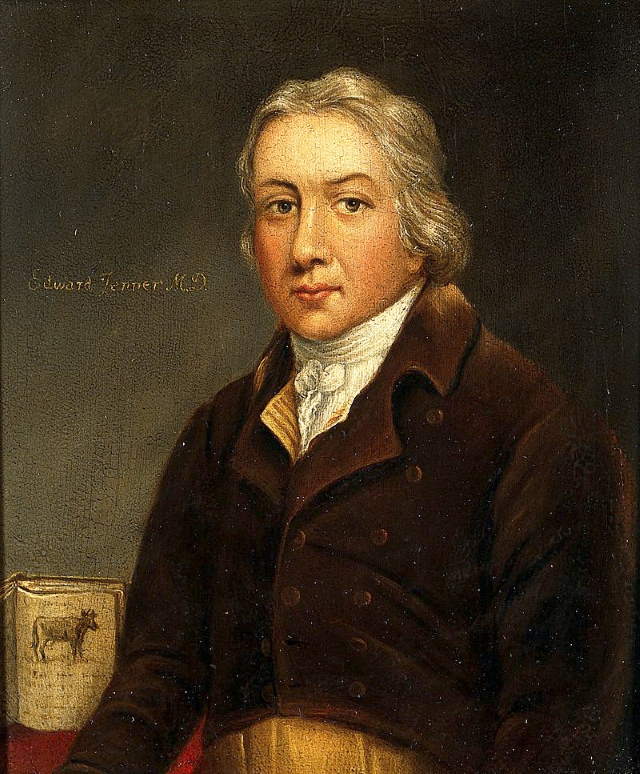
The basis for vaccination began in 1796 when an English doctor named Edward Jenner (17 May 1749 – 26 January 1823) observed that milkmaids who had gotten cowpox did not show any symptoms of smallpox after variolation. The first experiment to test this theory involved milkmaid Sarah Nelmes and James Phipps, the 9-year-old son of Jenner’s gardener. Dr. Jenner took material from a cowpox sore on Nelmes’ hand and inoculated it into Phipps’ arm.
Months later, Jenner exposed Phipps a number of times to the variola virus, but Phipps never developed smallpox. More experiments followed, and, in 1801, Jenner published his treatise “On the Origin of the Vaccine Inoculation,” in which he summarized his discoveries and expressed hope that “the annihilation of smallpox, the most dreadful scourge of the human species, must be the final result of this practice.”
The smallpox vaccine was the first vaccine to be developed against a contagious disease. The terms vaccine and vaccination are derived from Variolae vaccinae (smallpox of the cow), the term devised by Jenner to denote cowpox.
World Health Organization’s (WHO) Global Smallpox Eradication Program
In 1959, the World Health Organization (WHO) initiated a plan to rid the world of smallpox – the deadliest disease in the history of pandemics. Unfortunately, this global eradication campaign suffered from a lack of funds, personnel, and commitment from countries, as well as a shortage of vaccine donations. Despite their best efforts, smallpox was still widespread in 1966, causing regular outbreaks in multiple countries across South America, Africa, and Asia.
The Intensified Eradication Program began in 1967 with a promise of renewed efforts. This time, laboratories in many countries where smallpox occurred regularly (endemic countries) were able to produce more and in higher-quality freeze-dried vaccines. A number of other factors also played an important role in the success of the intensified efforts, including the development of the bifurcated needle, establishment of a surveillance system to detect and investigate cases, and mass vaccination campaigns, to name a few.
By the time the Intensified Eradication Program began in 1967, smallpox had already been eliminated in North America (1952) and Europe (1953), leaving South America, Asia, and Africa (smallpox was never widespread in Australia). The Program made steady progress toward ridding the world of this disease, and by 1971 smallpox was eradicated from South America, followed by Asia (1975), and finally Africa (1977).
The Antonine Plague (165 to 180 AD)
- Origin: Near East
- Affected area: Roman Empire
- Disease: Smallpox or measles
- Spread by: Airborne via coughing or sneezing
- Symptoms: Fever, swelling of the throat, diarrhea, and skin eruptions
- Mortality rate: 25%
- Deaths: 5 million
The Antonine Plague pandemic was brought to the Roman Empire by troops who were returning from campaigns in the Near East, present-day Iraq. Ancient sources agree that the epidemic appeared first during the Roman siege of Seleucia in the winter of 165-166. The true cause remains undetermined, but scholars think it was either smallpox or measles, based on its symptoms described by the Greek physician and writer Galen (129 AD – c210 AD, the disease is also known as the Plague of Galen).
The epidemic may have claimed the life of a Roman emperor, Lucius Verus, who died in 169 at 38 years old and was the co-regent of the great Marcus Aurelius Antoninus. Marcus Aurelius’ family name, Antoninus, has become associated with the epidemic.
According to the Roman historian Dio Cassius (155-235), the disease broke out again 9 years later and caused up to 2,000 deaths a day only in Rome. About one-quarter of those who were affected have died, which gives the disease a mortality rate of about 25%. The total deaths have been estimated at 5 million, and the disease killed as much as one-third of the population in some areas and devastated the Roman army.
The Plague of Justinian (541-542)
- Origin: Egypt
- Affected area: The Byzantine Empire
- Disease: Bubonic plague (Yersinia pestis, the same bacterium responsible for the Black Death between 1346-1353)
- Spread by: Fleas often carried on rodents
- Symptoms: Chills, malaise, fever, muscle cramps, seizures, gangrene and buboes in the neck, armpits, and groin
- Mortality rate: 80%
- Deaths: 5000 per day at its peak, an estimated 25-100 million during two centuries of recurrence
The Plague of Justinian was the first recorded pandemic of the bubonic plague, one of three types of plague caused by the bacterium Yersinia pestis (others being septicemic plague and pneumonic plague).
Yersinia pestis is originated in China and northeast India. It was carried to the Great Lakes region of Africa via overland and sea trade routes. The Byzantine historian Procopius of Caesarea (c500-c565) first reported the epidemic in 541 from the port of Pelusium, near Suez in Egypt.
At that time, North Africa was the primary source of grain for the Byzantine empire. The disease traveled to the capital city, Constantinople (modern-day İstanbul) by the black rat (Rattus rattus), which traveled on the grain ships and carts.
Procopius recorded that at its peak the plague was killing about 10,000 people in only Constantinople daily. The accuracy of the figure is in question, and the true number will probably never be known, though. He also noted that because there was no room to bury the dead, bodies were left stacked in the open. Funeral rites were often left unattended, and the entire city smelled like the dead.
Even the emperor himself, Justinian I (c482-565), contracted the disease but survived.
The number of deaths is uncertain. Some modern scholars believe that the plague killed up to 5,000 people per day in Constantinople at the peak of the pandemic. The initial plague ultimately killed perhaps 40% of the city’s inhabitants and caused the deaths of up to a quarter of the human population of the Eastern Mediterranean. An estimated 25-100 million people died during two centuries of recurrence until 750.
The Black Death (1346-1353)
- Origin: Central Asia or East Asia
- Affected area: Asia and Europe
- Disease: Bubonic, pneumonic, and septicemic plague (bacterium Yersinia pestis)
- Spread by: Fleas carried by rats
- Symptoms: Chills, malaise, fever, muscle cramps, seizures, gangrene, and buboes in the neck, armpits, and groin, vomiting of blood. Victims died within 2-7 days of infection.
- Mortality rate: 30%-90%
- Death rate: 30%-60% of the European population
- Deaths: 75-200 million
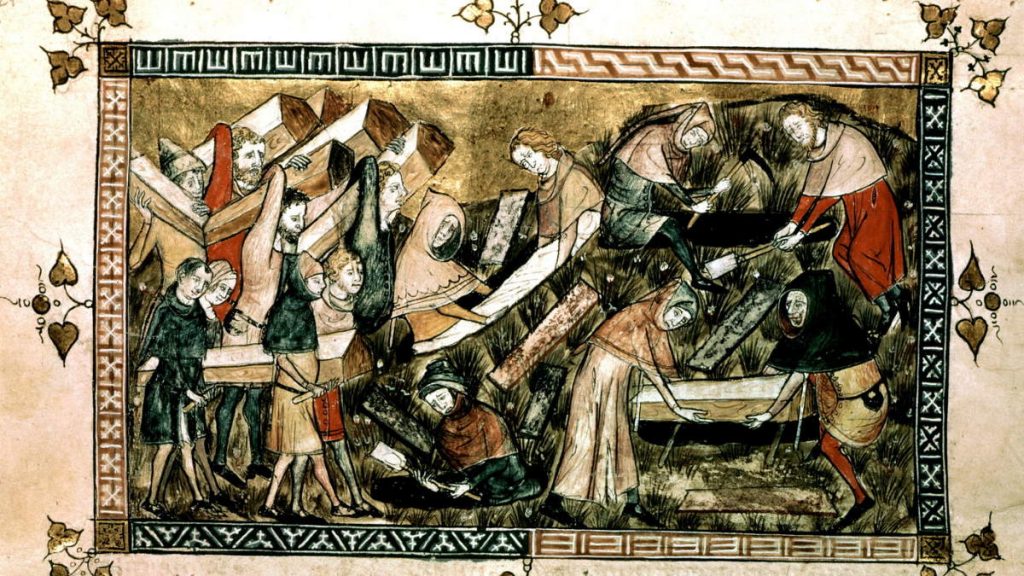
The black death – the most fatal and devastating pandemic recorded in history. When historians discuss “the plague”, they are usually referring to this epidemic of bubonic plague, the “black death”.
Origin of Black Death
Due to climate change in Central Asia in 1338, rodents carrying the disease began to flee the dried-out grasslands to more populated areas. The fleas they carried spread the bubonic plague in Asia.
Then, the disease carried by the traders along the Silk Road where it devastated every place it went. India and Mongolia left seriously depopulated. In the middle Middle East, including Iraq, Iran, and Syria, during this time, the death toll was about a third of the population – everywhere was covered by dead bodies.
By 1345, the pestilence reached Crimea. At that time, the port city of Kaffa was under siege by the Mongolian and Tatar armies, who were suffering from the disease. The attackers catapulted infected corpses over the city walls of Kaffa to infect the inhabitants.
It is more likely that infected rats traveled across the siege lines to spread the epidemic to the inhabitants, though.
The plague arrives in Europe
As the disease took hold, by the summer of 1347, Genoese traders in the besieged city fled across the Black Sea to Constantinople to escape the disease and death. But, they unwittingly carried deadly rats and their fleas with them. In Constantinople, the bubonic plague killed the 13-year-old son of the Byzantine emperor, John VI Kantakouzenos.
In October 1347, carried by twelve Genoese galleys, the plague arrived in Sicily. From there, the “black death” launched its carnage in Europe, where the population was already weakened by wars, malnutrition, and other diseases.
From Italy, the disease spread northwest across Europe, striking France, Spain, Portugal, and England by June 1348, then spread east and north through Germany, Scotland and Scandinavia from 1348 to 1350. It was introduced into Norway in 1349 when a ship landed at Askøy, then spread to Bjørgvin (modern Bergen) and Iceland.
Finally, the black death spread to northwestern Russia in 1351. The plague was somewhat more uncommon in parts of Europe with less developed trade with their neighbors, including the majority of the Basque Country, isolated parts of Belgium and the Netherlands, and even isolated Alpine villages throughout the continent.
There are no exact figures for the death toll of the black death. It is estimated that it killed some 75 to 200 million people in Eurasia. Between 30% – 60% of Europe’s population died.
The corpses filled the European cities, as graveyards reached capacity, and sometimes there was no one left to bury the dead. At least half of the populations of London and Paris perished.
The word quarantine emerged in Venice referring to 40 days ships were required to wait in the harbor before docking to ensure no one aboard was carrying the plague.
In modern times, if you get sick your parents take you to the doctor and you get some medicine to feel better, but in the fourteenth-century illnesses like “The Black Death” would spread from town to town, wiping out entire villages of people. In this educational animated video, The Infographics Show team looks at what made “The Black Death” so deadly.
Yersinia pestis
The cause of all three main forms of the plague, pneumonic, septicemic, and bubonic, Yersinia pestis was discovered in 1894 by Alexandre Yersin (22 September 1863 – 1 March 1943), a Swiss/French physician and bacteriologist from the Pasteur Institute.
Today, several classes of antibiotics are effective in treating the plague. Despite this, between 2010 and 2015 there were 3248 documented cases, which resulted in 584 deaths caused by bubonic plague only. Between 1998 and 2009, nearly 24,000 pneumonic plague cases have been reported, including about 2,000 deaths.
The septicemic plague was the least common of the three plague varieties that occurred during the Black Death. In 2015, Taylor Gaes, a 16-year-old in Larimer County in northern Colorado, contracted the septicemic plague and subsequently died after being bitten by a flea that had bitten a rodent on his family’s rural property.
Cocoliztli (1545-1578)
- Origin: Europe
- Affected area: Aztec Empire in modern-day Mexico
- Disease: Viral hemorrhagic fever related to the Ebola virus (new studies suggest it was salmonella, not a virus)
- Spread by: Poor hygiene, fecal matter
- Symptoms: Black tongue, bloody diarrhea, neurological disorders, bleeding from nose, eyes, and mouth.
- Deaths: 5-15 million
Known as Cocoliztli by the native Aztecs, which means the great pestilence, this epidemic caused millions of deaths in the territory of New Spain in present-day Mexico. Historical records suggest it was some type of hemorrhagic fever, like Ebola, but recent bacterial genomic studies have suggested that Salmonella was at least partially responsible for this initial outbreak.
The symptoms (black tongue, bloody diarrhea, neurological disorders, bleeding from nose, eyes, and mouth) were unlike anything the doctors of the time had seen. Unfortunate victims also had hallucinations and agonizing convulsions. They died in days.
Historical descriptions of the Cocoliztli certainly don’t sound like salmonella. But, maybe, the microbe wasn’t present in the Americas before Spanish conquistadors carried it there from Europe, and the locals may have lacked a strong natural immune response to it. They may also have been suffering years of malnutrition.
Whatever the reason, the results of the disease were devastating. At the time, historian Fray Juan de Torquemada (c. 1562 – 1624) wrote, “In the year 1576, great mortality and pestilence that lasted for more than a year overcame the Indians … the place we know as New Spain was left almost empty.”
An estimated 5-15 million people died. Many Astec cities and villages were left abandoned. The massive loss of life did more to make way for the Spanish conquest than swords and muskets ever could.
Smallpox, again (1509 – 1800s)
Cocoliztli was not the only disease Europeans shared with Native Americans. After the first contact with Europeans and Africans, some believe that the death of 90-95% of the native population of the New World was caused by Old World diseases. It is suspected that smallpox was the chief culprit and responsible for killing nearly all of the native inhabitants of the Americas.
Smallpox was introduced to the Caribbean island of Hispaniola in 1509 and spread to mainland North America in the following year. The indigenous population had no immunity to the disease, which caused a great population loss with 80-90 percent of the mortality rate.
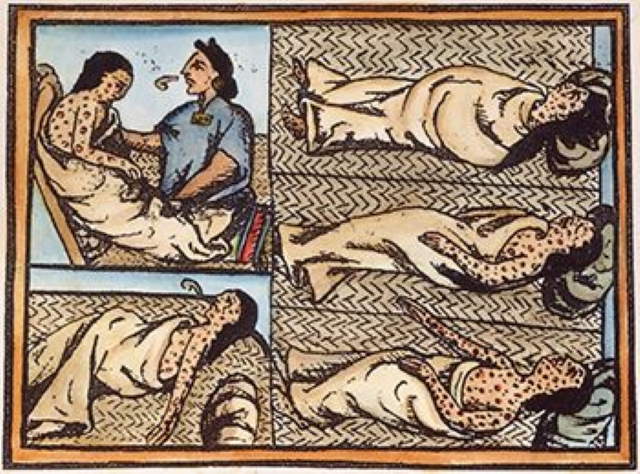
As with the Aztecs, smallpox paved the way for Europeans to colonize North America.
The effects of smallpox on Tahuantinsuyu (or the Inca empire) were even more devastating. Beginning in Colombia, smallpox spread rapidly before the Spanish invaders first arrived in the empire. The spread was probably aided by the efficient Inca road system. Within months, the disease had killed the Incan Emperor Huayna Capac, his successor, and most of the other leaders. Two of his surviving sons warred for power and, after a bloody and costly war, Atahualpa has become the new emperor.
As Atahualpa was returning to the capital Cuzco, Francisco Pizarro arrived and through a series of deceits captured the young leader and his best general. Within a few years, smallpox claimed between 60% and 90% of the Inca population, with other waves of European disease weakening them further.
In 1633 in Plymouth, Massachusetts, the Native Americans were struck by the virus. As it had done elsewhere, the virus wiped out entire population groups of Native Americans.
But, Europeans also suffered from the disease. For the better part of the 18th century, smallpox was the leading cause of death in Europe and worldwide. An estimated 400,000 Europeans died each year, and one in ten infants in Northern Europe would die of smallpox before reaching their 1st birthday.
Syphilis (1490s – 1928)
- Origin: The Americas
- Affected area: Europe
- Disease: Bacterium Treponema pallidum
- Spread by: Unprotected sex
- Symptoms: Fever, headaches, muscle pain, rashes and disfiguring sores; after the latent stage returns with dementia, dysfunction of organs, intense pain, and death.
- Mortality rate: 8%-58%, higher in men
- Death rate: 30%-60% of the European population
- Deaths: Underreported, but probably millions.
The spread of deadly diseases wasn’t one-way. A terrible infection, most native Americans immune to, was carried east across to the Atlantic and wreaked havoc in Europe.
This pandemic was Syphilis.
The first written records of an outbreak of syphilis in Europe occurred in 1494 or 1495 in Naples, Italy, during a French invasion (Italian War of 1494-98). Since it was claimed to have been spread by French troops, it was initially called the “French disease” by the people of Naples.
In 1530, the pastoral name “syphilis” (the name of a character) was first used by the Italian physician and poet Girolamo Fracastoro (c. 1476/8 – 6 August 1553) as the title of his Latin poem in dactylic hexameter describing the ravages of the disease in Italy.
From the 16th through the 19th century, syphilis was one of the main health problems in Europe. But, the number of infections and deaths were greatly underreported because of the shame and the social stigma that went along with the disease known to be contracted by sex.
Syphilis continued to devastate humanity until the Scottish biologist, physician, microbiologist, and pharmacological Sir Alexander Fleming (6 August 1881 – 11 March 1955) invented penicillin in 1928.
But, even as late as 2015, syphilis caused about 107,000 deaths, down from 202,000 in 1990.
Third Cholera Pandemic (1840s – 1860s)
- Origin: India
- Affected area: Worldwide
- Disease: Bacterium Vibrio cholerae
- Spread by: Water contaminated with fecal matter
- Symptoms: Severe diarrhea, vomiting, and muscle cramps which lead to deadly dehydration.
- Mortality rate: 50%-60%
- Death rate: 30%-60% of the European population
- Deaths: At least 52,000 in the UK, 1 million in Russia, millions worldwide
Descriptions of cholera are found as early as the 5th century BC in Sanskrit. But, it became a serious worldwide health problem in the mid-19th century.
Cholera is spread mostly by unsafe water and unsafe food that has been contaminated with human feces containing the bacteria. Undercooked seafood is a common source. Risk factors for the disease include poor sanitation, not enough clean drinking water, and poverty – all these were common in the 19th century worldwide.
John Snow
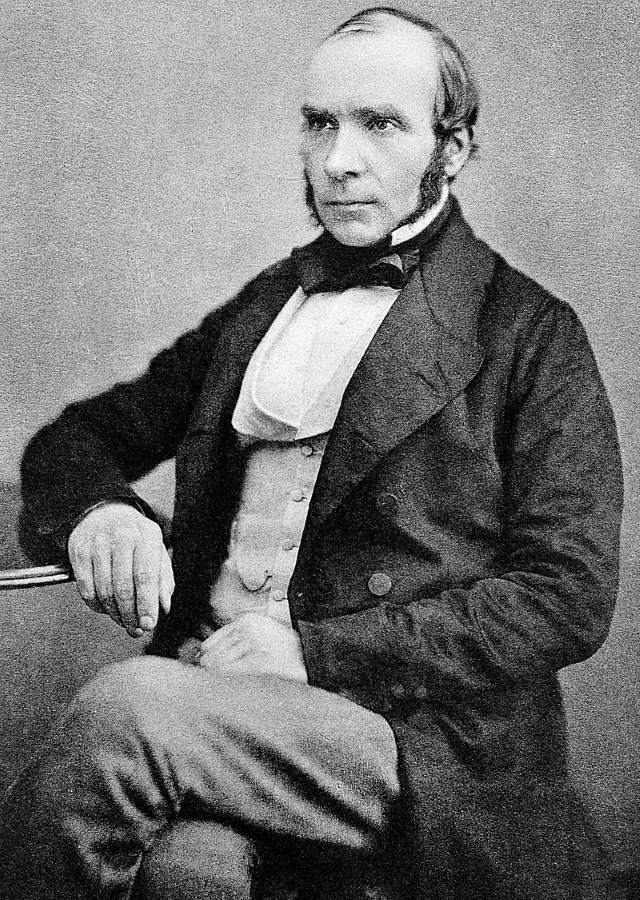
John Snow, not the Game of Thrones character, the English physician is an important figure in the history of pandemics.
In the 1850s, the germ theory of disease had not yet been developed and (now obsolete) Miasma theory that held diseases-such as cholera, chlamydia, or the Black Death were caused by a miasma (μίασμα, ancient Greek: “pollution”), a noxious form of “bad air”.
An English physician, John Snow (15 March 1813 – 16 June 1858) was skeptical about the Miasma theory. He traced the entire London cholera outbreak to a single water pump on Broad Street (now Broadwick Street) in the Soho neighborhood. Researchers later discovered that this public well had been dug only 3 feet (0.9 m) from an old cesspit, which had begun to leak fecal bacteria.
Officials were highly skeptical, but Snow’s studies of the pattern of the disease were convincing enough to persuade the local council to disable the water pump by removing its handle (force rod).
This action has been commonly credited as ending the outbreak, but, in fact, Snow observed that the epidemic may have already been in rapid decline.
Snow later used a dot map to illustrate the cluster of cholera cases around the pump. He also used statistics to illustrate the connection between the quality of the water source and cholera cases. He showed that the Southwark and Vauxhall Waterworks Company was taking water from sewage-polluted sections of the Thames and delivering the water to homes, leading to an increased incidence of cholera.
Snow’s studies taught health officials around the world the importance of water sanitation and public hygiene.
Unfortunately, due to people’s limited access to clean water in some regions, cholera still infects millions of people and causes about 130,000 deaths yearly.

Third Plague Pandemic (1855 – 1859)
- Origin: China
- Affected area: Primarily China and India
- Disease: Bubonic, pneumonic, and septicemic plague (bacterium Yersinia pestis)
- Spread by: Fleas carried by rats
- Symptoms: Chills, malaise, fever, muscle cramps, seizures, gangrene, and buboes in the neck, armpits, and groin, vomiting of blood. Victims died within 2-7 days of infection.
- Mortality rate: 30%-90%
- Deaths: 12 million
The plague again showed its ugly face, this time in the Yunnan province of China. It then spread to all inhabited continents via trading ships. But it showed the most devastating effects in India and China, with about 10 million killed in India alone and about 2 million in China.
Spanish Flu (1918 – 1920)
- Origin: Unknown
- Affected area: Worldwide
- Disease: H1N1 influenza virus
- Spread by: Airborne via coughing and sneezing
- Symptoms: Fever, cough, runny nose, sore throat, aches, fatigue, bleeding from the nose, ears, stomach, and intestines, immune system overdrive
- Mortality rate: 20%
- Deaths: Anywhere from 17 million to 50 million, and possibly as high as 100 million
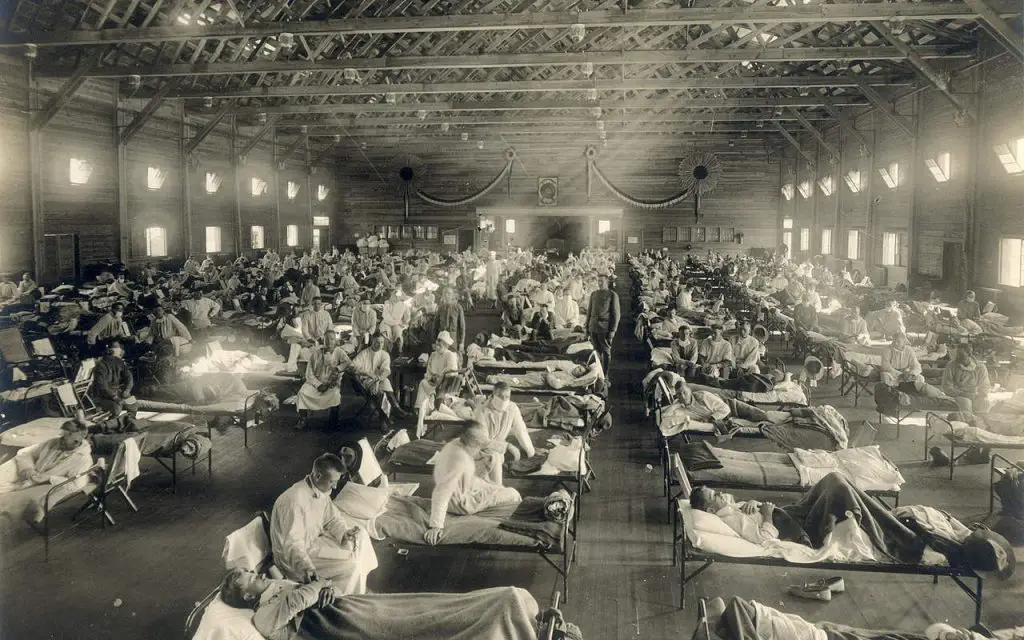
Just as the horror of the great war coming to an end, the world was struck by one of the deadliest pandemics in history.
It’s unclear where the rapid spread of the H1N1 influenza virus originated. To maintain morale, World War I censors minimized early reports of illness and mortality in Germany, the United Kingdom, France, and the United States. Newspapers were free to report the epidemic’s effects in neutral Spain, such as the grave illness of King Alfonso XIII (17 May 1886 – 28 February 1941), and these stories created a false impression of Spain as especially hard hit. This gave rise to the name Spanish flu.
Unlike seasonal influenza, which usually kills very young and very old, healthy young people are especially hit hard by the Spanish flu pandemic. Some analyses have shown the virus to be particularly deadly because it triggers a cytokine storm, which ravages the stronger immune system of young adults.
World War I troops, living and working in close quarters, and traveling around the world after the war was over, spread the deadly outbreak more rapidly. Even remote locations like the Pacific Islands and Antarctica were hit by the disease.
Many communities applied social isolation measures including canceling public events and closing the schools, which significantly reduced the spread of the disease. Unfortunately, in some places like Philadelphia, public health officials ignored warnings and didn’t cancel its Liberty Loan Parade on September 28, 1918, bringing 200,000 Philadelphians together. The results were devastating. More than 12,000 people died in six weeks. By the six-month mark, about 16,000 had died and there were more than half a million cases.
In San Fransisco, business and theatre owners remained open. by October 9, 1918, the city had at least 169 cases of influenza. Only a week later that number had jumped to over 2,000. San Francisco’s epidemic had started. The epidemic brought nearly 45,000 cases of influenza to San Francisco and killed over 3,000 of its residents in the fall of 1918 and the winter of 1919.
When it’s over, at least 500 million people were infected, and as many as 100 million people died of Spanish flu worldwide.
The Spanish flu was the first of two pandemics caused by the H1N1 influenza virus; the second was the swine flu in 2009.
Spanish Flu: a warning from history
100 years ago, celebrations marking the end of the First World War were cut short by the onslaught of a devastating disease – the 1918-19 influenza pandemic. Its early origins and initial geographical starting point still remain a mystery but in the Summer of 1918, there was a second wave of a far more virulent form of the influenza virus than anyone could have anticipated. Soon dubbed ‘Spanish Flu’ after its effects were reported in the country’s newspapers, the virus rapidly spread across much of the globe to become one of the worst natural disasters in human history.
To mark the centenary and to highlight vital scientific research, the University of Cambridge has made a new film exploring what we have learned about the Spanish Flu, the urgent threat posed by influenza today, and how scientists are preparing for future pandemics.
HIV/AIDS (1978-present)
- Origin: West Africa
- Affected area: Worldwide
- Disease: Human Immunodeficiency Virus (HIV)
- Spread by: Bodily fluids via unprotected sex, blood transfusions, hypodermic needles, and from mother to baby during pregnancy, delivering, and breastfeeding.
- Infections: At least 70 million and counting
- Deaths: At least 36 million and counting
COVID-19 (2019-present)
COVID-19 was declared a pandemic by the World Health Organization (WHO) on March 11, 2020.
- Origin: China
- Affected area: Worldwide
- Disease: COVID-19 virus
- Spread by: Airborne via coughing and sneezing, air distance, air currents, duration in air, humidity, duration on objects and surfaces, floor
- Symptoms: Typically causes flu-like symptoms including fever and cough. In some patients – particularly the elderly and others with other chronic health conditions – these symptoms can develop into pneumonia, with chest tightness, chest pain, and shortness of breath. It seems to start with a fever, followed by a dry cough. After a week, it can lead to shortness of breath, with about 20% of patients requiring hospital treatment.
- Mortality rate: 2% – 5%
- Deaths: 168,000 (as of April 20, 2020) and counting
Notes
- The Fertile Crescent is a crescent-shaped region in the Middle East, spanning modern-day Iraq, Syria, Lebanon, Israel, Palestine, Jordan, the northeast and Nile valley regions of Egypt, together with the southeastern region of Turkey and the western fringes of Iran. The region has been called the “cradle of civilization” because it is where settled farming first emerged as people started the process of clearance and modification of natural vegetation in order to grow newly domesticated plants as crops. As a result, the early human civilizations such as Sumer in Mesopotamia flourished. Technological advances in the region include the development of agriculture and the use of irrigation, of writing, the wheel, and glass, most emerging first in Mesopotamia.
Sources
- “Epidemic” vs. “Pandemic”: What Do These Terms Mean? on dictionary.com
- History of Smallpox on the Centers for Disease Control and Prevention (CDC) website
- Smallpox on Wikipedia
- “Smallpox in the New World” by Stephanie True Peters on Google books
- Edward Jenner on Wikipedia
- Antonine Plague on Wikipedia
- Plague of Justinian on Wikipedia
- Justinian’s Plague (541-542 CE) on the Ancient History Encyclopedia
- Bubonic plague on Wikipedia
- Black Death on Wikipedia
- Cocoliztli epidemics on Wikipedia
- “One of history’s worst epidemics may have been caused by a common microbe” on the Science Magazine website
- Syphilis – Symptoms and Causes on the Mayo Clinic website
- Syphilis on Wikipedia
- Cholera: causes, symptoms, treatment, and prevention on WebMD
- Cholera on the World Health Organization (WHO) website
- Cholera on Wikipedia
- John Snow on Wikipedia
- Spanish flu on Wikipedia
- Budget of NASA, Year by Year [1980-1989] - June 10, 2024
- Budget of NASA, Year by Year [1970-1979] - June 10, 2024
- Budget of NASA, Year by Year [1958-2024] - June 10, 2024
